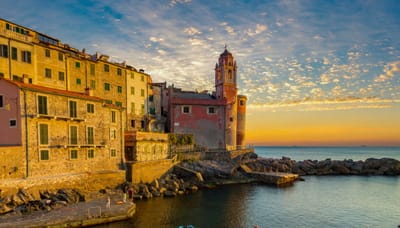TELLARO

There are places in the world that seem to be made to be remembered. Italy is full of them, with places like this. From north to south of the country, interspersed with cities of art and history, small villages similar to jewels steal the heart of those who visit them. This is the case of Tellaro, a fraction of the Ligurian Lerici.
Listed as one of the most beautiful villages in Italy, Tellaro is a small seaside village perched on a cliff, in the province of La Spezia. To reach it, take a panoramic road overlooking the sea, which - starting from Lerici - passes through Maralunga and then Fiascherino. The more adventurous, on the other hand, can choose one of the many paths - hidden among the harsh nature - that start from the villages above, and that descend towards the sea.
Tellaro
Arriving in Tellaro means dealing with a fairytale landscape: narrow and intertwined alleys, colorful houses, history that meets culture and gives life to splendid traditions. Like that of the night of December 24, when the Underwater Christmas takes place: carried by a group of divers, the statue of the Baby Jesus emerges from the water and then is deposited in a manger, with - in the background - the light of 8,000 candles and fires firework in the sky.
On the second Sunday of August, however, the Octopus Festival pays homage to a legend. It is said that, in the Middle Ages, a giant octopus saved Tellaro from the attack of the Saracens by ringing the church bells.
Tellaro
It is this mix of legends, history and nature that has made Tellaro famous among artists. The writer and journalist Mario Soldati, for example, chose to spend his old age here; Eugenio Montale stopped there during a train journey, and dedicated a poem to the village. Here, in fact, Italian and foreign painters and poets love to come, for a few days or for a while, conquered by the beauty of such an ancient place.
It is in 1300 that Tellaro's story begins. A plague epidemic spread to nearby villages, and the survivors settled here, in this corner of the Gulf of Poets. Subsequently, the village served to control the invaders who came from the sea: still today you can admire the walls that surround the houses, and two of the three watchtowers built for the purpose (one is located inside the Oratory of Santa Maria, the other is today the bell tower of the church of San Giorgio).
Tellaro
Then, there are the beaches. From the church of San Giorgio you can reach one, with a marina and a cliff perfect for sunbathing. Pedestrian paths instead lead to the free and equipped beaches of Fiascherino, while during the summer you can reach Punta Corvo, Punta Bianca and Bocca di Magra by ferry.
Listed as one of the most beautiful villages in Italy, Tellaro is a small seaside village perched on a cliff, in the province of La Spezia. To reach it, take a panoramic road overlooking the sea, which - starting from Lerici - passes through Maralunga and then Fiascherino. The more adventurous, on the other hand, can choose one of the many paths - hidden among the harsh nature - that start from the villages above, and that descend towards the sea.
Tellaro
Arriving in Tellaro means dealing with a fairytale landscape: narrow and intertwined alleys, colorful houses, history that meets culture and gives life to splendid traditions. Like that of the night of December 24, when the Underwater Christmas takes place: carried by a group of divers, the statue of the Baby Jesus emerges from the water and then is deposited in a manger, with - in the background - the light of 8,000 candles and fires firework in the sky.
On the second Sunday of August, however, the Octopus Festival pays homage to a legend. It is said that, in the Middle Ages, a giant octopus saved Tellaro from the attack of the Saracens by ringing the church bells.
Tellaro
It is this mix of legends, history and nature that has made Tellaro famous among artists. The writer and journalist Mario Soldati, for example, chose to spend his old age here; Eugenio Montale stopped there during a train journey, and dedicated a poem to the village. Here, in fact, Italian and foreign painters and poets love to come, for a few days or for a while, conquered by the beauty of such an ancient place.
It is in 1300 that Tellaro's story begins. A plague epidemic spread to nearby villages, and the survivors settled here, in this corner of the Gulf of Poets. Subsequently, the village served to control the invaders who came from the sea: still today you can admire the walls that surround the houses, and two of the three watchtowers built for the purpose (one is located inside the Oratory of Santa Maria, the other is today the bell tower of the church of San Giorgio).
Tellaro
Then, there are the beaches. From the church of San Giorgio you can reach one, with a marina and a cliff perfect for sunbathing. Pedestrian paths instead lead to the free and equipped beaches of Fiascherino, while during the summer you can reach Punta Corvo, Punta Bianca and Bocca di Magra by ferry.


